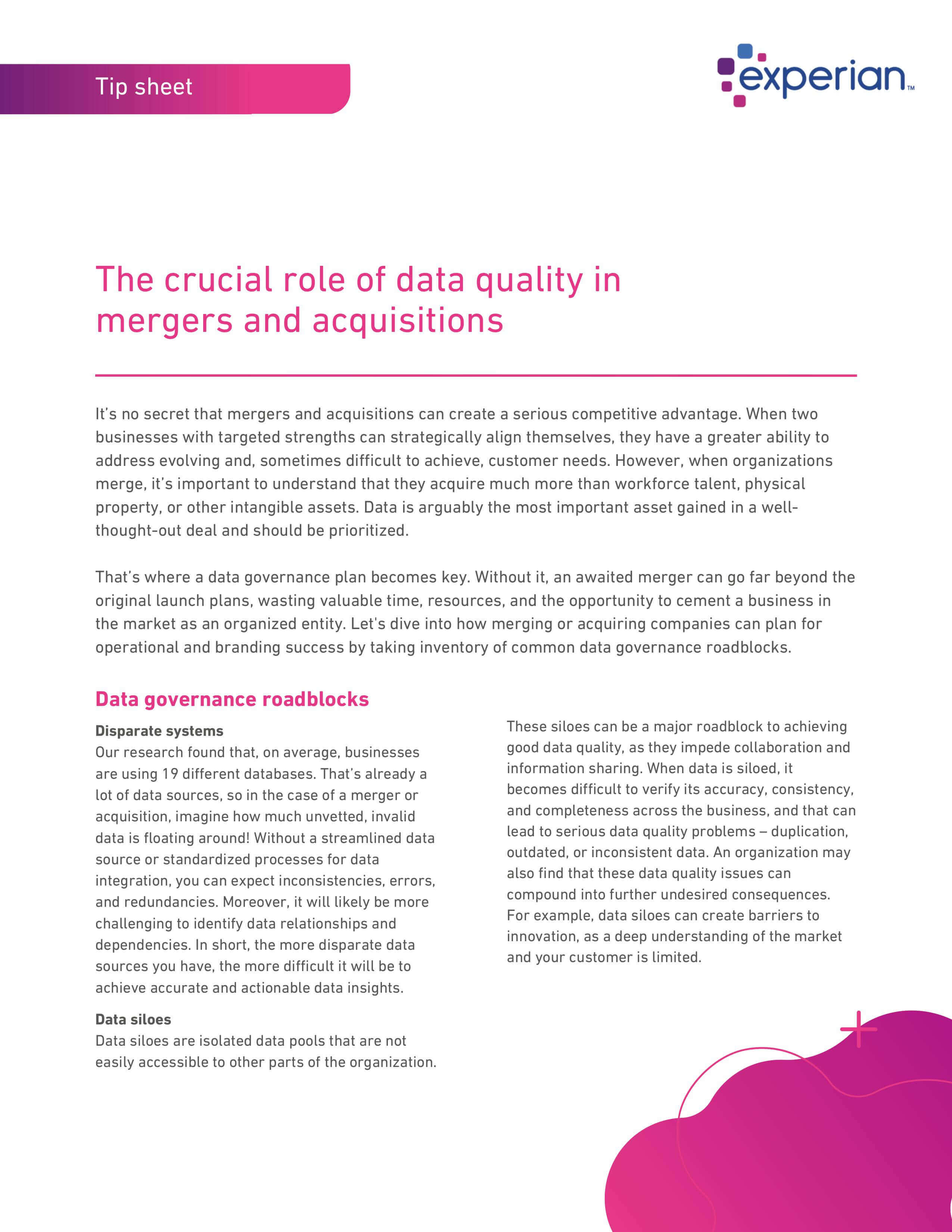- Products

Enjoy a free 30-day trial of our
data validation software.Experience the power of trusted data
solutions today, no credit card required! - Solutions

Enjoy a free 30-day trial of our
data validation software.Experience the power of trusted data
solutions today, no credit card required! - Partners

Enjoy a free 30-day trial of our
data validation software.Experience the power of trusted data
solutions today, no credit card required! - Learn more
- Pricing
- Contact Us
The critical role of data quality in mergers and acquisitions
It’s no secret that mergers and acquisitions can create a serious competitive advantage. When two businesses with targeted strengths can strategically align themselves, they have a greater ability to address evolving and, sometimes difficult to achieve, customer needs. However, when organizations merge, it’s important to understand that they acquire much more than workforce talent, physical property, or other intangible assets. Data is arguably the most important asset gained in a well-thought-out deal and should be prioritized.
That’s where a data governance plan becomes key. Without it, an awaited merger can go far beyond the original launch plans, wasting valuable time, resources, and the opportunity to cement a business in the market as an organized entity. Let's dive into how merging or acquiring companies can plan for operational and branding success by taking inventory of common data governance roadblocks.
Data governance roadblocks
Disparate systems
Our research found that, on average, businesses are using 19 different databases. That’s already a lot of data sources, so in the case of a merger or acquisition, imagine how much unvetted, invalid data is floating around! Without a streamlined data source or standardized processes for data integration, you can expect inconsistencies, errors, and redundancies. Moreover, it will likely be more challenging to identify data relationships and dependencies. In short, the more disparate data sources you have, the more difficult it will be to achieve accurate and actionable data insights.
Data siloes
Data siloes are isolated data pools that are not easily accessible to other parts of the organization. These siloes can be a major roadblock to achieving good data quality, as they impede collaboration and information sharing. When data is siloed, it becomes difficult to verify its accuracy, consistency, and completeness across the business, and that can lead to serious data quality problems – duplication, outdated, or inconsistent data. An organization may also find that these data quality issues can compound into further undesired consequences. For example, data siloes can create barriers to innovation, as a deep understanding of the market and your customer is limited.
Distrust in the data
Another rollover consequence of bad data is an overall distrust in company data. In fact, in our research, 39% of business leaders said that poor data quality damages trust in their analytics. The fallout isn’t just internal to the business either: 40%of business leaders also said that poor data quality negatively impacts reputation and customer trust.
Organizations need to break down data siloes and adopt a collaborative approach to data management, where data is treated as a strategic asset that is shared and governed across the entire organization. When employees do not trust the accuracy or completeness of customer data, they may hesitate to use it, hindering the ability to make informed, strategic decisions and provide great service to customers. Moreover, if they do use unreliable data, they may be risking customer relationships.
Enhance data accuracy
A single customer view can enhance data accuracy by verifying and validating customer data against external sources, such as credit bureaus, social media, and public records.
Streamline data management and eliminate siloes
A single customer view can help to maintain data consistency by ensuring that all systems and applications use the same customer data, reducing the risk of discrepancies and conflicts.
A single customer view
Data consolidation is the gathering and storing of varied data in a single place. Data consolidation can make data more fit for insights and decision-making in several ways. One example of data consolidation is a single customer view, a concept based on unifying all customer instances to a single record and, in many cases, cross-linking all the data on that client into one trustworthy view. This view is largely useful for Product, Marketing, and customer support teams, which are key to affirming branding and positioning post-merger or post-acquisition.
Eliminate duplicate data
It can help to reduce data duplication by connecting customer records from different sources into a unified profile. This reduces the risk of errors and inconsistencies in the data.
Improved decision-making
Having a single customer view enables businesses to better understand their customers' preferences and behaviors, leading to more accurate segmentation and targeting
Enhance data completeness
It can improve data completeness by filling in missing information, such as contact details, transaction history, and customer interactions.
Enhance data accuracy
A single customer view can enhance data accuracy by verifying and validating customer data against external sources, such as credit bureaus, social media, and public records.
Streamline data management and eliminate siloes
A single customer view can help to maintain data consistency by ensuring that all systems and applications use the same customer data, reducing the risk of discrepancies and conflicts.
Experian can help
The current business landscape is moving rapidly, and you want your newly unified business to be up and running as soon as possible.
Experian Aperture Data Studio gives you unprecedented insight into all of your business’s information. Our data quality platform accepts data from a variety of sources. Whether you’re dealing with spreadsheets, Hadoop clusters, or relational databases, it’s the go-to solution for data management projects. With powerful data profiling, discovery, cleansing, and enrichment capabilities, getting insight into your business’s data is now easier and faster than ever before.
